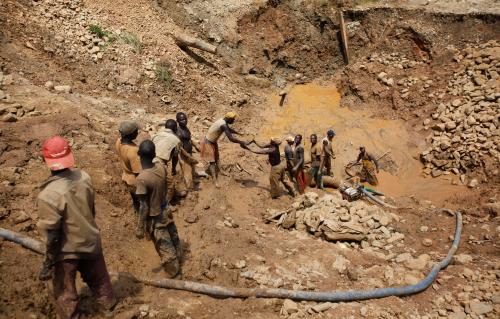For years, economists and political scientists have studied and advised national governments throughout the world on how to optimize natural resource revenues for long-term development. A major challenge often unaddressed by development plans is the governance of extraction by communities closest to a mine or oil and gas field.
Usually, national governments negotiate extraction contracts with companies and collect revenues. Local actors, however, see their physical and economic landscape change most dramatically. Experience responding to the economic and political impacts of natural resource wealth has shown that for a country to fully benefit, subnational governance issues must be addressed.
Why subnational governance work really matters
Addressing subnational governance is critical because local dissatisfaction can derail a project. Examples jump from the headlines. For the last month, several Native American tribes have physically blocked construction of a pipeline in North Dakota, with concerns over the potential impacts to their water supply and access to sacred sites. Employees at a phosphate mine in Togo are on strike demanding better wages and more protective gear. Anthropologists and environmental activists have tried to bring attention to social and environmental effects of mining for years, but local impacts are often dismissed as separate issues instead of integral to the nation’s chances of benefiting from resource wealth. In truth, each work stoppage can have huge costs for the entire country. Researchers at Harvard found that community conflicts over environmental and social concerns can cost up to $20 million a week for large-scale mines.
It’s not just a question of lost revenues. When members of local communities do not feel like they are benefiting from a national extraction project, conflict can result. Analysts point to 20 resource-fueled civil wars since World War II. One of the keys to bringing lasting peace in Myanmar is addressing how the costs and benefits of natural resources are shared between the ethnic groups and the national government.
Many national governments already share resource management powers with local government, and shared responsibilities are often significant. For example, Bolivia decentralized more than $2 billion of its oil revenues in 2012. In Indonesia, local governments have the power to grant or deny licenses for many mining projects. When development actors only address resource management issues with national governments, they risk missing large areas of impact.
Unfortunately, resource management or revenue sharing systems are often designed in a reactionary manner. In some cases, poor design can lead to gaps or overlapping national and local government authority. In others, it can increase the opportunity for conflict, corruption, and waste.
How to approach subnational resource governance
Supporting good resource governance at the local level is not easy. Even the definition of the problem looks different at the subnational level—academics debate whether there is a subnational resource curse and how to characterize it.
Natural Resource Governance Institute researchers have concluded a series of policy papers, including a synthesis paper, to support local governments and civil society actors as they aim to improve governance of natural resource wealth. The takeaway: while many of the good practices required at the national level do apply at the subnational level, one cannot simply cut-and-paste national level solutions into subnational resource governance challenges.
One of the biggest differences is that responsibilities delegated to local authorities are not always matched with the institutions and policy options needed to manage the challenges. Consider an example of revenue management. The prevailing wisdom is that countries can avoid distortions from resource revenues by decoupling spending from expenditures. Figure 1 illustrates how the U.S. state of Wyoming was able to smooth expenditure spending during volatile commodity prices using a savings fund. In contrast, the state of Bayelsa in Nigeria had more than an 80 percent change in spending from one year to the next.
Figure 1: Short- to medium-term expenditure volatility in Bayelsa and Wyoming

Source: Bauer, A. (2013), “Subnational Oil, Gas and Mineral Revenue Management.” NRGI.
Many resource-rich subnational governments don’t have the same policy options as Wyoming. Instead, national governments often forbid subnational governments from borrowing or saving revenues. In Indonesia, district governments, are required to repay the national government any revenue they don’t spend by the end of the year. The local leaders of Bojonegoro, an oil-rich district in Indonesia with just over a million people, want to do better. They convinced the national government to allow the first local savings fund in the country. The broader policy lesson is that subnational governments must be given the tools to address resource management challenges.
Even when given the power of policy options, local governments often struggle with the capacity to manage things well. In addition to the challenge of filling expert positions, unsynchronized accounting or title systems can stall local governance and scare off investment. Power asymmetries between levels of government can hamper the local government’s opportunity to collect revenues. Low capacity of oversight institutions, including civil society, can increase chances for corruption.
A framework for subnational resource governance policy analysis and recommendations
The Natural Resource Charter provides a useful framework to analyze decisions that governments need to make in converting natural resource wealth below the ground into long-term sustainable development. From the decision to extract to investing for sustainable development, each step in the decision chain is crucial for governments to avoid common pitfalls of the “resource curse.”
Figure 2: The Natural Resource Charter decision chain and salient subnational components

Policymakers can consider how governance challenges are similar and different at the subnational level. Even when subnational governments are not delegated the full authority for one area, there are often implications for subnational governance. The Natural Resource Governance Institute’s series of policy papers (see Figure 2) highlight key points across the decision chain:
- Deciding to extract/licensing: Governments must coordinate licensing information systems vertically (between the national and subnational governments) and horizontally (between subnational governments), while recognizing the full spectrum of land rights.
- Getting a good deal (revenue sharing): Any revenue sharing scheme should have clear objectives aligned with subnational expenditure responsibilities and management capacities.
- Getting a good deal (local content): Local content plans should be coordinated with local development plans. The national government must be transparent about the negotiating process and the real costs associated with local content promises.
- Managing resources: Local governments should implement revenue management best practices, including using fiscal rules. National governments must allow local governments the tools to match their resources.
- Investing for sustainable development: Local and national governments can use the resource revenues to improve subnational investment systems so that future spending is more efficient while fostering non-extractives areas of the economy.
- Transparency: Information must be disaggregated on a project-by-project basis and available in formats that can be accessed and absorbed by subnational communities at each step in the decision chain.
It cannot be overstated how hard it is to get subnational resource governance right. Given the capacity and policy challenges, resource governance may be even harder to do well at the local level than at the national level. The good news is that with support and access to information, many subnational governments are leading the charge for better resource management. Learning from their counterparts in Bojonegoro, civil society groups and local governments in the Compostela Valley of the Philippines were able to create detailed transparency mechanisms. The local level work informed a national multi-stakeholder implementation of the Extractive Industries Transparency Initiative. Local innovations like these can keep the momentum going during national efforts to improve resource governance.







Commentary
Close to home: The critical importance of subnational governance in oil, gas, and mining
September 27, 2016